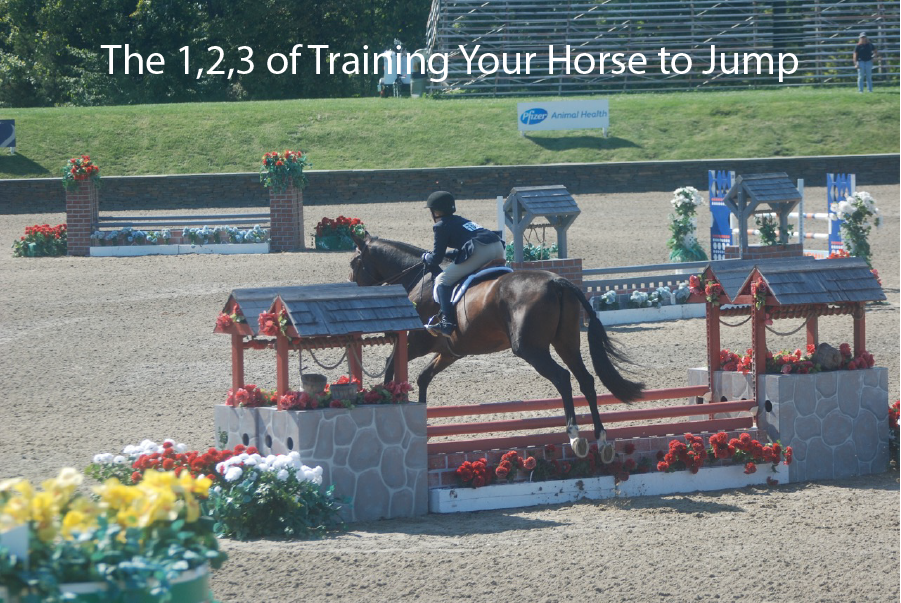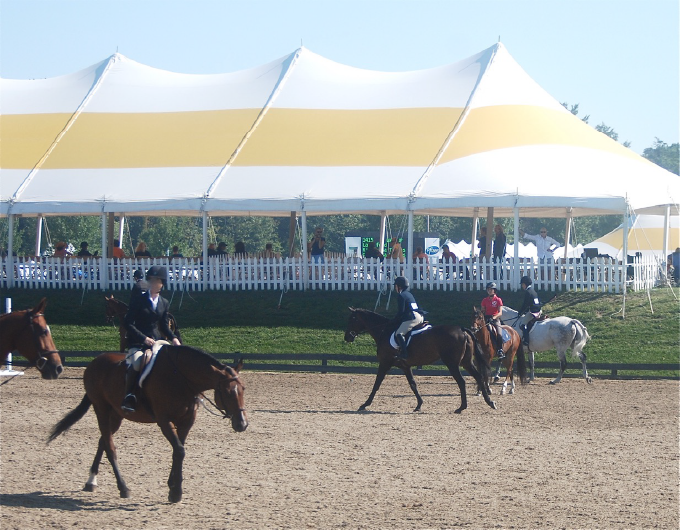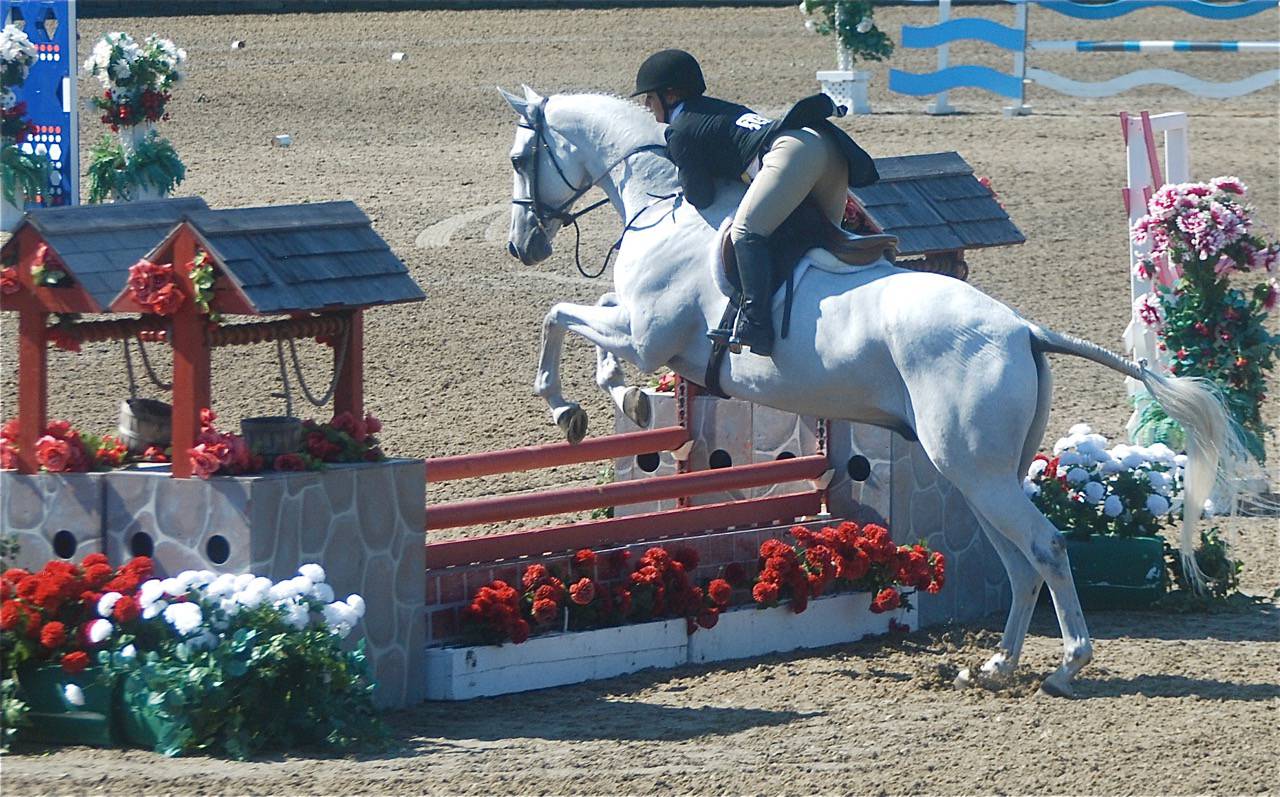The 1,2,3 of Training Your Horse to Jump
by Nikki Alvin-Smith

There is a tremendous amount of fun to be enjoyed jumping your horse. Even as an advanced dressage trainer, I strongly believe every horse should be schooled in jumping as part of his basic education before specializing. Dressage is good for jumpers and jumping is good for dressage horses. These exercises are great for a horse at any stage of training and from any discipline because when properly executed they develop the horse’s strength, topline and athletic ability.
When I was a kid growing up in England I trained many young horses to jump and was allowed to exercise the Grand Prix level horses between rounds to keep them warmed up. I was fortunate to be neighbors with two international level showjumper folks who held top level events and schooled international teams at their farms. As you can imagine this was a delight for this horse crazy teenager and there was not a free moment I did not spend working for free in exchange for lessons and riding opportunities.
So how do you jump into this wondrous adventure. Here are the 1,2 and 3’s of it. The preparation and tools you need; the execution of jumping successfully; and finally a few tips on how to resolve issues that may occur during the training process.
Be Prepared
You will need to have your horse schooled in the basics of walk, trot and canter before you start. Hopefully in a snaffle bridle and an all-purpose or jumping saddle which offer great security for the rider. For your horse, especially if he is shod all around you should bell boot him and apply protective leg boots. These items offer protection from missteps, hitting poles and also provide support for shock absorption on landing and ligament and tendon support on take off.

As a rider you should consider an ASTM certified riding helmet, gloves and suitable footwear mandatory equipment.
To begin start on the longe line and walk your horse over a ground pole set on the circle without side reins attached. Your horse needs his head free so he can look and balance. If you lay poles on the ground for grid training it is a good idea to use a support system of plastic rail raisers. These will keep the poles from being kicked or rolled which can result in a twisted fetlock.
You should move along with the horse and not hit him in the mouth with the longe line if he cat jumps and send him on with the longe whip if he balks. Do this in both directions. Once your horse calmly walks the pole in each direction you can ask the same at a trot and then at the canter. Always aim your horse at the center of the pole, as when you jump you will always seek to take the center of the fence at the basic levels. You can use cavaletti on the lowest setting too but be certain not to catch the line on the sides of the jump.
I am not an advocate of jumping the horse over large fences on the longe line because of the risk of catching the line on the jumping stand. Also, for larger fences the horse should have the ability to use both hind legs during take-off during early training. Consistently schooling your horse over single fences on the longe will not only make him sore, but it will also make him one sided, particularly as many trainers just longe to the left when schooling fences on the longe line. When the trainer then rides the horse over fences after a turn to the right they will be surprised when he runs out to the left. Just as in dressage you want your horse balanced and supple in both directions.
Next approach the same exercise in the saddle. It is safest to always have a ground person in attendance during jumping training just in case of an accident. The ground person is also there to adjust fences for the rider. A noble job and please remember to thank them!
Be sure that you focus on keeping the horse in a quiet rhythm both before and after the pole. You can slightly lighten your seat in the saddle but at this small height you won’t need to move into much of a forward jumping position. This will come later as you practice your two-point jumping position. Release your hands forward as the horse jumps the pole and maintain a soft contact with your calf on the horse’s side, evenly on both sides to support your base position and keep him straight over the fence.
This is a great exercise to teach yourself how to judge distances especially when you can canter the pole. If the distance looks short for take-off then half halt on the rein or just close your hand. If it looks a reach then give with the hands toward the poll of the horse to encourage him to stretch forward.
What is the ideal stride distance? This depends on the size and scope of your individual horse. The average horse stride is 12 feet and a pony would be closer to 9 feet but you must be flexible and evaluate this based on your own horse. When you are schooling a horse on a chute/free schooling in a line the distances will be shorter as in any schooling. This is because in competition there may be speed involved and speed equals longer strides. Setting up a ménage or chute jumping is also a very useful tool for training horses to jump but you may not have the equipment or experience to utilize this at this stage so for the purposes of simplicity and safety we’ll leave that to another article.
Once you have mastered the single pole you can use poles to make a grid. Add one pole at a time on a straight line to a maximum of six. Now you can close the angle of your hip and assume the 2-point position. Keep your eyes softly focused and looking between the ears of your horse and look down just with your eyes, not your head, for the next pole. The important factor here is the horse must maintain relaxation and rhythm and the rider must not restrict the horse. If your horse does rush use intermittent short half halts to remind him to come back to you and post slower.
Once these exercises are happily mastered and the horse is enjoying them with calmness and sensibility then you can use the grid poles on a figure eight to encourage the horse to switch bend, four on each side of the circles.
It is important not to overtire the horse with pole grid exercises as the ‘ask’ is great on all the horse’s joints and his mental focus. Like most training, little and often and correct work is the key to success. This is very important if you have moved along to raising the poles from the floor as in a row of cavaletti. Once you raise the poles off the floor to any degree you should always adopt a forward light seat.
You should be able to ride these exercises at both trot and canter before moving up.
So, the preparation is complete. Now onto part two – the cross pole and parallel fences.
The Cross Pole Cometh
Let the fun begin! Your horse is now (hopefully) completely comfortable with ground poles and has learned how to position his feet using the ground pole grid exercises. Now you can use one ground pole as a trot reminder pole when approaching any fence. This will facilitate calmness and give both rider and horse time to look at the fence and gauge the distance for take-off. The distance between trot pole reminder and the 18-inch-high cross rail will be set at 6-9 ft depending on the scope and stride of your horse.
As you approach the cross pole fence it is important that as a rider you can keep your position with a closed hip and shoulders up and open without collapsing in your hip. Remember if you lean too much forward you will drive your horse into the ground before take-off so be sure you have developed the balance before starting this exercise.
Approach in a trot and allow your horse to do the jumping and don’t get out ahead of him. Use both legs quietly with a slight pressure from your calves in unison. Once your horse can do this at a trot allow him to canter to the fence and count one, two, three before take-off spot to encourage him. Bring him back to the trot after the fence to teach him not to rush off.
After the fence it is important to keep him in the same calm rhythm as you had as you approached the fence. Do not take the fence again until your horse is calm and relaxed.
Once your horse jumps the cross rail with ease you can try him over a small parallel (oxer) fence. The top rail should be eighteen inches off the ground, and if you add a ground pole on each side that is eighteen inches from the top rail on each side, it will make the fence very inviting to jump correctly.
When you horse is happy with both styles of fence you can place one after the other.
Add three or four trotting poles four or five feet apart and give them a seven to nine feet distance to the cross rail.
The distance between cross rail and parallel (oxer) should be 8-10 ft for landing and then 8-10 ft to the parallel i.e. 16 to 20 ft apart between the cross rail and the ground pole belonging to the parallel. You do not want a ‘bounce’ fence at this stage of training and if the fences were closer then this would be the ask.

This exercise will test your skill as a rider because as your horse takes the cross rail you must exercise a minimum body movement. If you have been leaning too much forward to the cross pole this exercise will tell you. Why? Because between the cross rail and the parallel if you leaned too far forward for the cross rail then you’ll have to pull yourself back up to straighten to the parallel, which will destroy your horse’s balance. This in turn will encourage him to tense and rush and maybe hollow his back. You need to learn to become more ‘still’ between the obstacles and not over lean into the first fence. The rider’s balance and body control directly affects the horse so if you have issues this is the first place to look.
Something Went Wrong
If you horse is stopping or hesitating at a fence then you either do not have enough impulsion or he is nervous or tense about jumping or even sore. For soreness, aside from checking saddle and tack fit in general and having the knowledge he is sound on the flat, be sure not to over-face your horse or to over-jump him and do not jump him on hard surfaces. Quality footing is extremely important to maintain soundness and comfort. As with any horse training, take your horse back to basics without rider and then with rider. Be absolutely certain you are not hitting him in the mouth when he jumps. If he balks at fences you can use verbal encouragement. I would not advocate going to the whip or bat unless you have some professional help on the ground.
If your horse rushes after the fence then this can also stem from nervousness or excitement. Once again take him back to basic work over poles and grids. If use of a calming voice and half halts does not bring your horse back into rhythm after the fence then add a ground pole after the fence about 12 to 18 feet after the last obstacle. Your horse will see this as he sails over the last fence and it should catch his attention and cause him to pause momentarily to facilitate your aids being listened to and he should collect and shorten his stride and sit back on his rear end. This added pole is very useful for any horse that needs re-schooling and has been allowed to run after a jump. Do not just haul on the reins as this will cause the horse to pull and run faster than ever and then before you know it, you will contemplate the addition of a harsher bit.
If you longe your horse over ground poles on a circle and he persistently throws his head up and hollows his back, you can add loose side reins to give him an indicator to bring his head down and bascule his back. I would not advocate using side reins when the grid or poles are higher as the horse will need freedom of his head and neck for balance.
Always remember your horse needs his head and neck to balance and you must not catch him in the mouth or upset his balance when you are riding. Work on both your own strength and position and work on his also.
If your horse likes to run out to avoid a fence, consider adding a pole to the side of the fence out to the side as a guide rail. If a horse tries to go sideways and run out it is a good idea to use an opening rein and outside leg firmly and push him back to the fence keeping his head facing the fence. Do not allow him to make the choice to run out or turn away. Even if you don’t ask him to jump the fence from a standstill, try to make the point that turning away or running out is not his decision and when you do turn him around to try the fence again make it a deliberate maneuver with strong leg aids.
In conclusion there are many more fun facets to jumping to learn that are beyond the scope of this article. You will learn how to use diagonal aids, how to turn your horse while in the air (airborne turns), lead swaps, open and closing circles, learn how to negotiate courses and different types of fences. I hope this ‘101’ article will help you and your horse discover the joys of jumping.


